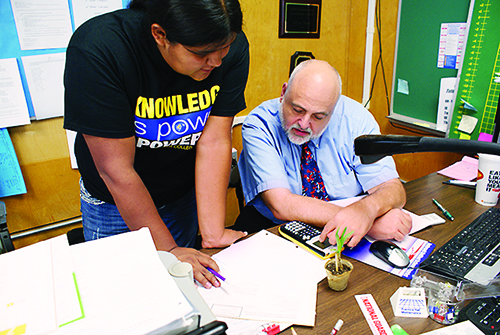 Preparation for the rigors of college studies begins with dual enrollment programs at 19 area high schools in which students earn both high school and Northland Pioneer College credits for college-level courses taught at the high school.
Preparation for the rigors of college studies begins with dual enrollment programs at 19 area high schools in which students earn both high school and Northland Pioneer College credits for college-level courses taught at the high school.
“Parents and students don’t have an understanding of what a wonderful program this is,” said Jeff Strong, a dual enrollment mathematics instructor at Holbrook High School (HHS). There is no tuition for dual enrollment courses, and, in most cases, textbooks are supplied by the high schools.

NPC dual enrollment instructor Jeff Strong works with a Calculus student at Holbrook High School. Students earn both high school and college credits at the same time.
“And students have another advantage: articulation agreements with the state’s three universities to accept community college credits. That is a wonderful thing for Arizona students,” Strong continues. He taught dual enrollment courses in South Carolina before joining the HHS staff nine years ago. Out-of-state colleges and universities are also accepting NPC credits. “My son’s dual enrollment credits were accepted at BYU,” Strong says. Other students come back and tell him their math credits were accepted at their colleges and universities. In many cases, those credits met or exceeded college degree requirements.
Strong cites numerous examples of student success after dual enrollment. A typical example is two Calculus I and II students who received premier scholarships to attend the University of Arizona. One is doing extremely well in engineering studies, the other in broadcast journalism. A third student completed the two calculus courses and is now studying early childhood education at Arizona State University. “She said she has a stronger math background than most ECD majors and is considering a minor in math education,” relates Strong.
“Students tell me how the rigor of instruction in dual enrollment courses helped prepare them for college.” Instructors build a lasting relationship with their students, with most classes meeting daily. “That is a significant difference from traditional college classes that meet three hours a week. Dual students receive almost twice the contact hours, aiding a student’s success,” he said.
At Holbrook High School, calculus students attend two class periods a day: one for theory and one for doing homework, working together in study groups or asking for one-on-one assistance. “We offer up to 14 credit hours of mathematics in our dual enrollment program,” Strong said.
“Mathematics is about opportunities. Knowing math makes you more valuable in whatever field you go into.” But mathematics is just one field of study in dual enrollment programs. Parents should speak to their student’s high school adviser to see what courses are available.
The NPC College Bound scholarship is also available for high school students who want to take college classes in the evening or during the summer. The scholarship is open to all high school and home school students in Navajo and Apache counties and covers tuition costs for up to 7 general education credits per NPC semester with a cap of 28 credits per student.
Strong loves to teach and is following in his father’s footsteps. “He has always been my role model and is still teaching in his late 70s at a regional campus of the University of South Carolina.”
The younger Strong had also taught at USC for 10 years before deciding to “go back to high school.” He says it was the right move for him. “Every time I changed jobs, I grew to enjoy it more.” Strong has been teaching now for 28 years and plans to continue.
– Everett Robinson

